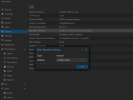The next issue I'm facing is that, with 10gbe, I am running 3 networks: Corosync, Ceph and backup. But with the Infiniband cards, I only have two ports per node. The first network I am going to replace is backup. But I then need to decide what to do with the other two networks.
- Only switch one to Infiniband and keep the other on 10gbe? Ideally, I would like to get rid of the 10gbe network, as it is (also) a big power draw.
- Only switch one to Infiniband and switch the other over to normal 1gbe ethernet? The one to go one 1gbe probably would be Corosync. But not sure if this could be problematic (it used to work for me back when I started and everything was on 1gbe).
- Switch both to Infiniband by using vlans (if vlans exist on IB - no idea)? If that is possible, which two should I put on one cable (because they would cannibalize each other the least)?
Thanks!
- Only switch one to Infiniband and keep the other on 10gbe? Ideally, I would like to get rid of the 10gbe network, as it is (also) a big power draw.
- Only switch one to Infiniband and switch the other over to normal 1gbe ethernet? The one to go one 1gbe probably would be Corosync. But not sure if this could be problematic (it used to work for me back when I started and everything was on 1gbe).
- Switch both to Infiniband by using vlans (if vlans exist on IB - no idea)? If that is possible, which two should I put on one cable (because they would cannibalize each other the least)?
Thanks!


